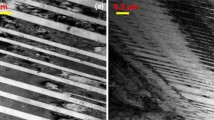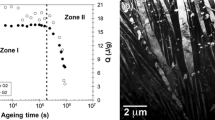Abstract
In this article, the influence of Co addition on phase transformation behavior and mechanical properties of TiNiFe shape memory alloy was investigated extensively. Differential scanning calorimetry (DSC) measurements shows that martensitic start transformation temperatures (M s) decrease drastically with increasing Co content, while the R phase transformation start temperatures (R s) vary slightly. Nevertheless, the substitution of Ni with Co does not exert substantial influence on the two-stage transformation behavior of the TiNiFe alloy. The results from stress–strain curves indicate that higher critical stress for stress-induced martensitic transformation (σ SIM) has been obtained because of Co addition. In such cases, the Ti50Ni48Fe1Co1.0 alloy maintains a good shape memory effect, and a maximum recoverable strain of 7.5 % can be obtained.
Similar content being viewed by others
Avoid common mistakes on your manuscript.
1 Introduction
As is well known, NiTi-based alloys have been considered to be the most attractive candidate material for functional engineering applications because of their excellent shape memory effect [1–6]. In particular, TiNiFe [7–10] attracted more and more attention owing to high recovery strain, low martensite transformation temperature, low density, and extraordinary corrosion resistance. For engineering materials, the critical stress for stress-induced martensitic transformation (σ SIM) is a significant parameter. When loading stress exceeds σ SIM of raw materials, stress-induced martensitic transformation occurs, leading to loosening and failure of sections. Therefore, it is important to enhance the σ SIM of shape memory alloys.
The investigation that Co addition can increase the yield strength and decrease the martensitic start temperature (M s) of NiTi alloys has been reported [11–14]. Sui et al. [11] reported that the addition of Co to TiNiNb alloy led to increase the yield strength and decrease the M s, because of suppressing the formation of Ti2Ni. Jing et al. [12] also found that the addition of Co to TiNi alloy generated evident decrement of M s. However, few previous literatures stated the effect of Co addition to TiNiFe alloy. This article explored the influence of Co addition on phase transformation behavior and mechanical properties of TiNiFe shape memory alloy. As proposed in this article, obvious decrement of M s and prominent increment of σ SIM were obtained via Co addition.
2 Experimental
Four ingots of quaternary alloys with the nominal composition of Ti50Ni49−x Fe1Co x (x = 0, 0.5, 1.0, and 1.5) were prepared by induction melting of a mixture of 99.9 % pure Ti, 99.9 % pure Ni, 99.9 % pure Fe, and 99.7 % Co in a high-frequency vacuum furnace. Ingots were remelted four times and then were homogenized in evacuated quartz tubes at 850 °C for 24 h. Then, ingots were hot rolled into plates with a thickness of 1.2 mm. Specimens for measurements were spark cut from the plates. All the samples were solution treated at 850 °C in evacuated quartz tubes for 1 h, followed by quenching into water.
The phase transformation temperatures were determined by a Q2000 differential scanning calorimetry (DSC). The temperatures ranged from −90 to 100 °C, with a heating/cooling rate of 10 °C·min−1. Phase identification was performed on a Rigaku D/max-rB X-ray diffractometer (XRD) with Cu Kα radiation with scan speed of 6 (°)·min−1. Mechanical properties were detected on an MTS model 880 with a strain rate of 5.6 × 10−4 at room temperature (25 °C). Shape memory effect was also performed on the same device at −196 °C, and then, prestrained samples were heated to 100 °C to measure the recovery strain.
3 Results and discussion
Figure 1a shows the DSC curves of the Ti50Ni49−x Fe1Co x (x = 0, 0.5, 1.0, 1.5) alloys. It can be seen that all of the DSC curves exhibite two exothermic peaks and one endothermic peak. Obviously, the exothermic peaks can be attributed to B2 → R and R → B19′ transformations, and the endothermic peak to B19′ → B2. In addition, Co addition remarkably decreases R s, M s, and austenitic start temperature (A s), although the addition of Co does not change the transformation sequence. The effect of Co content on phase transformation temperatures (M s and R s) is shown in Fig. 1b. One can see that M s drops drastically with increasing Co content, whereas R s decreases slightly. For example, decreasing rate of M s (i.e., from 18 to −23 °C) is twice that of R s (i.e., from 35 to 15 °C). In such cases, the transformation hysteresis (A f−M s) [15] is obviously widened, which increases from 33 to 74 °C. The present results are consistent with those of a previously reported study [12].
Figure 2 shows the XRD patterns of Ti50Ni49−x Fe1Co x alloys. It reveals that R phase and B2 parent phase coexist in the alloys when Co addition is less than 1.5 %, implying that the R s values of alloys are all slightly higher than room temperature. With the increase of Co content, the intensity of R-phase peaks becomes weaker and weaker. Eventually, the peaks of R phase disappear when the addition of Co content reaches 1.5 at%. Combining the DSC curves in Fig. 1, the weakening of R-phase peaks can be ascribed to the decrease of R s caused by Co addition.
Figure 3 shows the stress–strain curves of Ti50Ni49−x Fe1Co x alloys. It is demonstrated that the critical stresses for stress-induced B19′ martensitic transformation (σ SIM) increase with the increase of Co content from 0, 0.5 %, to 1 %. As described in Fig. 1, the M s decreases with increasing Co content. As a result, the ΔT (T−T 0; T and T 0 representing deforming temperature and M s, respectively) increases with the increasing Co content, generating an increase of driving force corresponding to stress-induced martensitic transformation. This can be responsible for the enhancement in critical stresses. In addition, no stress-induced martensitic transformation is observed in Ti50Ni47.5Fe1Co1.5 alloy, in which the M s is decreased to −23 °C, which is much lower than the deformation temperature, because of the excess Co addition. In such a case, the yielding is associated with permanent plastic deformation.
As shown in Fig. 3, Ti50Ni49−x Fe1Co x alloy performs high critical stresses because of alloying appropriate Co content, which might be a potential candidate for advanced SMA. Thus, it is necessary to further investigate the shape memory effect of Ti50Ni49−x Fe1Co x alloys.
Figure 4 shows the shape memory test results of Ti50Ni49−x Fe1Co x (x = 0, 1.0) alloys. It is demonstrated that the recovery strain increases with increasing prestrain level, and the maximum complete recovery strain value of 7.5 % is obtained in TiNiFeCo alloy, compared with 7.8 % in TiNiFe alloy. Moreover, the recovery ratio is quite high up to about 85 % even if the prestrain is 12 %. Deformation exceeding 7.5 % leads to permanent plastic deformation, and only partial recovery can be obtained. In such a case, TiNiFeCo alloy maintains excellent shape memory effect, exhibiting high recovery ratio.
4 Conclusion
Addition of Co quaternary element drastically reduces M s. However, the R s temperatures decrease slightly. The decreasing rate of M s temperature (i.e., from 18 to −23 °C) is approximately twice that of R s (i.e., from 35 to 15 °C). Doping Co quaternary element to Ti50Ni49Fe1 alloy can improve the σ SIM of the TiNiFe alloy. Stress-induced martensitic transformation vanishes when Co content reaches 1.5 %. Doping Co quaternary element slightly deteriorates the shape memory effect. Nonetheless, Ti50Ni48Fe1Co1.0 alloy maintains good recovery ratio and recovery strain, obtaining the maximum recovery strain of 7.5 %.
References
Liu FS, Ding Z, Li Y, Xu HB. Phase transformation behaviors and mechanical properties of TiNiMo shape memory alloys. Intermetallics. 2005;13(3–4):357.
Xu HB, Jiang CB, Gong SK, Feng G. Martensitic transformation of the Ti50Ni48Fe2 alloy deformed at different temperatures. Mater Sci Eng A. 2000;28(1–2):234.
Zheng YF, Zhao LC. NiTi Alloys Applied in the Medical Field. Beijing: Science Press; 2004. 57.
Xu Q, Liu FS. Transformation behavior and shape memory effect of Ti50−x Ni48Fe2Nb x alloys by aging treatment. Rare Met. 2012;3(14):311.
Liu Y, Liu FS. Transformation behaviors of Ti48.5Ni48Fe2Nb1.5 dependence of annealing and thermomechanical cycling. Rare Met. 2012;31(3):231.
Uchil J, Ganesh Kumara K, Mashesh KK. Effect of heat treatment temperature and thermal cycling on phase transformations in Ni–Ti–Cr alloy. J Alloys Compd. 2001;325(5):210.
Marquina ML, Jiménez M, Marquina V, Aburto S, Ridaura R, Gómez R, Escudero R, Ríos-Jara D. Structural transitions in a TiNiFe shape memory alloy. Mater Charact. 1994;32(3):189.
Goo E, Duerig T, Melton K, Sinclair R. Mechanical twinning in Ti50Ni47Fe3 and Ti49Ni51 alloys. Acta Met. 1985;33(9):1725.
Hwang CM, Meichle M, Salamon MB, Wayman CM. Transformation behaviour of a Ti50Ni47Fe3 alloy I. Premartensitic phenomena and the incommensurate phase. Philos Mag A. 1983;47(C4):231.
Moberly WJ, Proft JL, Duerig TW, Sinclair R. Deformation, twinning and thermo-mechanical strengthening of Ti50Ni47Fe3. Acta Met Mater. 1990;38(12):2601.
Sui JH, Gao ZY, Li YF, Zhang ZG, Cai W. A study on NiTiNbCo shape memory alloy. Mater Sci Eng A. 2009;508(1):33.
Jing RR, Liu FS. The influence of Co addition on phase transformation behavior and mechanical properties of TiNi alloys. Chin J Aeronaut. 2007;20(2):153.
Kishi Y, Yajiba Z, Shimizu K. Relation between tensile deformation behavior and microstructure in a Ti–Ni–Co shape memory alloy. Mater Trans. 2002;43(5):834.
Hosoda H. Martensite transformation temperatures and mechanical properties of ternary NiTi alloys with off-stoichiometric compositions. Intermetallics. 1998;6(4):291.
Liu YN, Calvin SP. Criteria for pseudoelasticity in near-equiatomic NiTi shape memory alloys. Acta Mater. 1997;45(11):4431.
Acknowledgment
This project was financially supported by the National Natural Science Foundation of China (No. 50921003) and the Industry, Education and Research Projects of the China Aviation Industrial (No.cxy2012BH04).
Author information
Authors and Affiliations
Corresponding author
Rights and permissions
About this article
Cite this article
Chen, B., Liu, FS. Phase transformation behavior and mechanical properties of Ti50Ni49−x Fe1Co x shape memory alloys. Rare Met. 32, 225–227 (2013). https://doi.org/10.1007/s12598-013-0073-6
Received:
Revised:
Accepted:
Published:
Issue Date:
DOI: https://doi.org/10.1007/s12598-013-0073-6








